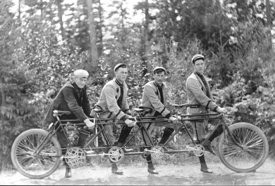Cycle Babble: Places



The bicycle produced new geographies in Victoria. Many of the changes are related to the modernist project that Norcliffe identifies. There are connections to economic, social, public and visible places. In some ways, the bicycle helped create the city we know today.
Visible Places: Parks & Racetracks
Norcliffe writes that, “The new geography produced by the bicycle was characterized not only by the compression of space... It was, in addition, strongly connected with a number of very visible spaces... Bicycling was usually a public exercise.”(1) He discusses three places in which the bicycle interacted with the public sphere in the “pursuit of modernity”: the racetrack, the photographic studio and “the parks and streets where cyclists could act out the role of 'flâneur on wheels.'”(2) There is good evidence that racetracks and parks played a big part in bicycle use in Victoria during the 1890s. It's more difficult to connect the technologies of photography and cycling in Victoria through photographic studios, as Norcliffe does in Eastern Canada. Searches at the B.C. Archives and City of Victoria archives indicate there are not many surviving pictures of bicycles owners showing off their new toys inside studios in Victoria dating from that time. However, photography was used by some citizens of Victoria to take pictures of them and their bicycles in parks, allowing them to make their trend-setting use of both technologies visible in public spaces.
New Geographies
Copyright 2009. Vincent Gornall
Four friends on a tandem bicycle, “Going Places.” City of Victoria Archives PR91-7960 M08267.






